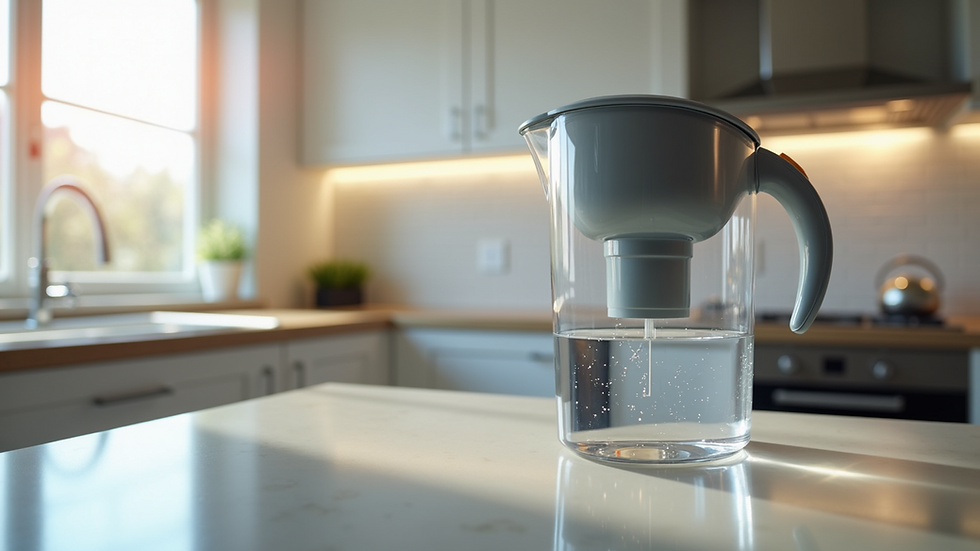Home Water Filters 101: What You Need and What You Don’t
- Mike Walbert
- Aug 1
- 3 min read
Water is vital for life, and access to clean, safe water is a priority for many households. However, with so many options available, selecting the right home water filter can be daunting. Do you really need one? Which type meets your specific needs? Let’s simplify this process together.
Understanding Water Filters
Home water filters vary widely, each catering to different filtration needs. They range from basic pitcher filters to advanced reverse osmosis systems. Knowing how each type functions helps you make an informed choice.
Pitcher Filters
Pitcher filters rank high in popularity for several reasons: affordability and ease of use. These filters use activated carbon to reduce chlorine, sediment, and some heavy metals from tap water.
For instance, a study showed that pitcher filters can reduce chlorine levels by approximately 96%, improving the taste and odor of water. However, it's crucial to note that they might not eliminate harmful bacteria or viruses. If you source water from a municipal supply solely for taste enhancement, a pitcher filter could be an effective solution.
Faucet-Mounted Filters
Faucet-mounted filters offer a practical and direct way to access filtered water. Mounted directly on the tap, they generally provide higher water output than pitcher systems. A quality faucet filter can remove around 99% of lead and significantly reduce other common contaminants like chlorine.
Furthermore, these systems allow users to switch between filtered and unfiltered water with ease. However, the effectiveness of these filters varies; be sure to check for certifications from recognized organizations to confirm their filtration capabilities.
Under-Sink Filters
For those seeking a long-term solution, under-sink filters are an excellent option. These systems often incorporate multiple filtration stages, including activated carbon and, in many cases, reverse osmosis, to produce high-quality drinking water.
Research indicates that under-sink filters can remove contaminants such as lead, chlorine, fluoride, and bacteria, often achieving over 99% reduction rates for these impurities. While installation might require a bit of plumbing knowledge, the consistent supply of clean water can justify the investment, especially for families that consume substantial amounts of water.
Whole House Filters
For comprehensive filtration solutions, whole house filters ensure every drop of water in your home—from drinking to showering—is purified. These systems remove sediment, chlorine, and multiple impurities, significantly improving the quality of water throughout your home.
Though costlier, typically ranging from $900 to $3,000 depending on the system and installation, whole house filters can be worthwhile for households with high water usage or known water quality issues.
What Do Water Filters Remove?
Understanding which contaminants your filter can handle is crucial for selecting the right one. Common impurities found in drinking water include:
Chlorine: Often used in municipal water systems, it can leave an unpleasant aftertaste and odor.
Lead: This toxic metal commonly leaches into drinking water from aging pipes, making its removal essential for health.
Sediment: Particles such as dirt and rust can not only affect taste but also lead to plumbing issues.
Harmful Bacteria: Certain filters can eliminate bacteria and viruses, providing an extra safeguard, particularly in regions with questionable water safety records.
Key Filtration Standards
When evaluating water filters, certifications from reputable organizations like NSF International or the Water Quality Association (WQA) provide assurance that the filter has been tested for effectiveness. Filters with these certifications often meet rigorous performance standards.
Choosing the Right Filter for You
Now that you understand the various filters and what they eliminate, it’s time to assess your specific requirements. Here’s how to narrow down your options:
Assess Your Water Quality: Conducting a water test at home or utilizing municipal water quality reports is a smart first step. This helps identify specific contaminants and guides your filter choice.
Determine Your Budget: Prices for water filters can range significantly. While it is important to invest in a quality system, establish a budget that suits your financial situation without compromising safety.
Consider Your Water Needs: Evaluate how much filtered water your household consumes. Smaller households may find a pitcher filter sufficient, while larger families might benefit from under-sink units or whole house systems.
Check Maintenance Requirements: All filters require some maintenance, whether it’s regular cartridge replacement or occasional system checks. Understanding these needs can help you make a more informed decision.
Making an Informed Decision
Investing in a home water filter can lead to better health outcomes and improved hydration. By considering the different types of filters, their contaminant removal capabilities, and your personal needs, you can make a sound choice without overspending.
Whether opting for a simple pitcher filter or a comprehensive whole house solution, thorough research ensures that you select the best fit for your home.

In summary, even though not everyone requires a complex filtration system, ensuring that your water is clean, safe, and pleasant to drink is achievable. By understanding your options, you’ll be better positioned to select the right solution for your home. Happy filtering!



Comments